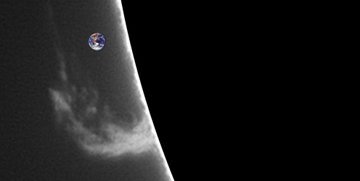 The space shuttle and the ISS are orbiting Earth. Would you like to see them? Sign up for Spaceweather PHONE.
The space shuttle and the ISS are orbiting Earth. Would you like to see them? Sign up for Spaceweather PHONE.
SOLAR WIND: Earth will brush past a solar wind stream later today or tomorrow, possibly sparking a mild geomagnetic storm. Northern sky watchers should be alert for auroras.
NOCTILUCENT CLOUDS: Last night when the sun was setting in Vallentuna, Sweden, the horizon lit up with fine, electric-blue ripples of light. "It was a fantastic display," says P-M Heden who took this picture:

These are noctilucent clouds, floating 80 km above Earth at the edge of space. What seeds them? Why were they never seen before the 19th century? Are they spreading? NASA is launching a satellite named AIM to investigate.
The night sky is still full of mystery. Keep looking up.
more images: from Doug Hill of Banff Scotland; from Tim Lundström of Nyköping, Sweden;
WORLD CUP: Yesterday, Cai-Uso Wohler of Bispingen, Germany, photographed a prominence curling over the sun's eastern limb--"announcing a new active region?" he wonders.

"World Cup." Credit: Cai-Uso Wohler.
We'll find out soon enough. In a day or so, the spinning sun will turn the root of the prominence toward Earth where it can be seen directly. Stay tuned for updates.
more images: from Robert Arnold on the Isle of Skye, Scotland; from Les Marczi of Welland, Ontario;

